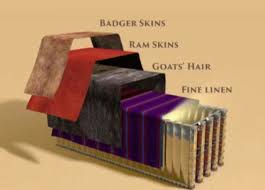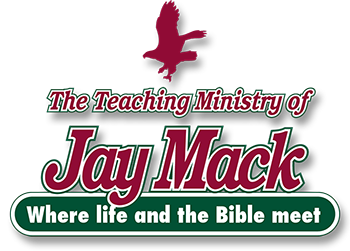Animal Skins on the Sanctuary
26:7-14 and 36:14-19
Animal skins on the Sanctuary DIG: What were the three last coverings made of? Why were they needed? What was the difference in their different lengths? In their durability? What is generally associated with goats in the Scriptures? Why were the ram skins dyed red?
REFLECT: If you could design and build a special place where you could feel close to God, what would it look like? How big would it be? How would you furnish it? What would be the focal point?

Each of the remaining three coverings for the Sanctuary had its own symbolic meaning. Over the white curtains of twisted linen hung eleven curtains made of goat hair. The goat’s hair foreshadowed Christ’s death on the cross. They were all to be the same size – thirty cubits, or forty-five feet wide and four cubits, and six feet long. Each set was thirty feet long by forty-five feet wide. When the two sets were woven together by the women (36:26), they were sixty feet long and forty-five feet wide. They were longer on both sides than the inner white linen curtains (45 feet rather than 42 feet), so they could touch the ground on both sides of the Sanctuary (26:7-8, 13, 36:14-15). The length of the Sanctuary was the same as the curtains of goat hair that covered it, or sixty feet, leaving the entrance for the outer veil. This hid from view the brilliant colors on the white curtains and protected the costly pieces of gold furniture.562 Therefore, just as God tabernacled in human skin (see the commentary on The Life of Christ, to see link click Af – The Memra of God), He also tabernacled in animal skin.
In connection with many of Isra’el’s great feasts, when the people were collectively represented before God, the goat was the only animal to be sacrificed for sin. Isra’el’s calendar year began with the feasts of Passover and Unleavened Bread. During the seven days of these feasts (among other sacrifices), a goat was slain for a sin offering (Numbers 28:17-22). The next feast was Weeks. We should not be surprised that a goat was offered as a sin offering there as well (Leviticus 23:15-19). Then came the feast of Trumpets, and there also the goat for a sin offering was used (Numbers 29:1-5). Following this came the most solemn of them all, the Day of Atonement, where a special sin offering was made of two goats. One of the goats was slain and the other led out into the desert after the sins of the nation were symbolically transferred to it (Leviticus 16). Finally came the Feast of Tabernacles, the feast of ingathering, when Israel rested from their toil and rejoiced in the blessing of God upon their labors. This feast lasted for eight days and on each day, a goat was slain as a sin offering (Numbers 29).
In addition, it is very striking to find that the goat generally depicts evildoing. Rebekah placed goatskins upon Jacob’s hands and neck to deceive Isaac (Genesis 27:16). Joseph’s brothers slaughtered a goat and dipped his robe in the blood to deceive their father (Genesis 37:31). Michal deceived Saul by putting an idol on his bed and putting some goats’ hair at the head (First Samuel 19:13). And finally, Jesus, contrasts the saved of His flock, the sheep, to the wicked lost, or the goats (see my commentary on Revelation Fc – The Sheep and the Goats).563
Five of the curtains were joined together into one set and the other six into another set. The sixth curtain was folded double at the front, covering the outer veil. Fifty loops were made along the edge of the end curtain in one set and also along the edge of the end curtain in the other set. Fifty bronze clasps then fastened the tent together as a unit. Unlike the gold clasps for the inner white curtains, those clasps of the outer coverings were made of bronze. This is significant because bronze symbolized divine judgment. So when Jesus became sin on our behalf, He suffered the wrath of God (Isaiah 53:10; Zechariah 13:7; Second Corinthians 5:21; First Peter 2:24). As for the additional length of the curtains, six feet of the woven curtain that was left over was to hang down at the rear of the Sanctuary leaving a clearance for the outer veil in the front (26:9-12, 36:16-18).
The last two external coverings of the Sanctuary give us two very different views of Christ and His ministry here on earth. They show how He was viewed from God’s perspective and from man’s perspective. The ram skins dyed red, pictured Christ’s devotion and obedience as seen by ADONAI. Over the curtains of goat hair there was a covering of ram skins dyed red (26:14a). The ram was the sacrifice used in the ordination of the priest when he began his ministry (29:26). It spoke, therefore, of devotedness to God. It was a ram that took the place of Isaac when Abraham bound his son and laid him on the altar (Genesis 22:13). Likewise, Christ was perfectly devoted to ADONAI and was always about His Father’s business (Luke 2:49; John 9:4). Zeal for His Father’s name consumed Him (John 2:17). So the ram skins dyed red pointed to the blood of Christ. He laid down His life willingly in obedience to the Father’s command (John 10:18). At the cross, mankind only saw the execution of a condemned criminal, but heaven looked down and saw the unequaled devotion and obedience of the Son to His heavenly Father.564
During the last three hours on the cross (from noon until three o’clock), when ADONAI poured out His wrath on Christ, darkness came over the whole land and the sun stopped shining (Mark 15:33; Luke 24:44-45). The word for the whole land means the whole inhabited earth. Therefore, the blackness of the whole inhabited earth was as black as the curtains of goat hair covering the Sanctuary that symbolized Christ’s death.
The hides of sea cows symbolized Christ as He appeared before men. On top of the ram skins, visible to those in the courtyard or in the camp of Isra’el, there was a covering of hides of sea cows (26:14b, 36:19). The dugong, or sea cow, feeds on herbs or other vegetable matter. It grows to about ten to twelve feet long, and has a round head and divided tail. It is often found among the coral rocks of the Red Sea.565 Those strong, durable hides protected the other coverings, and the furniture inside the Sanctuary from sun and rain, from dew and desert sand. These hides alone would be seen by the eyes of men as Isra’el traveled in the wilderness. It points to the fact that Christ made Himself nothing, taking the very nature of a servant (Philippians 2:7). Born in a manger; brought up in despised Nazareth; working at the carpenter’s bench; these were examples of what the rough and unattractive hides of sea cows foreshadowed. He humbled Himself and His divine glory was hidden from the eyes of sinful mankind. When those who looked down on Him said: Isn’t this the carpenter’s son (Mark 6:3), it merely showed the contempt they had for Him. They could not see the spiritual grace or the heavenly beauty that lay beneath. When they said: As for this fellow, we don’t even know where He comes from (John 9:29), it revealed the fact that they saw only the hides of sea cows.
It was the same at the time of His death. Just as the desert tribes passed by the Sanctuary not seeing the beautiful white linen curtains underneath, so the morbid throngs at the cross did not understand what they were witnessing. Many were astonished when they saw Christ, because His appearance was so disfigured that it didn’t look like any man, His form marred beyond human likeness (Isaiah 52:14). They viewed Him as utterly helpless, unable to come down from the cross. When they said: He saved others but He can’t save Himself (Mark 15:31b), it revealed that they only saw the hides of sea cows.
It is very interesting to realize that, in sharp contrast from the ten white linen curtains and the eleven black curtains made of goat’s hair, that no dimensions were given for the two outer coverings. This can only mean that what they symbolized was beyond measure. There was a depth and a height both in Christ’s devotedness to ADONAI and in His humiliation before men that was, and is, completely impossible for us to estimate.566



Leave A Comment